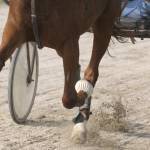What Is the Effect on Performance When Horses Are Fed Different Diets?

Three Standardbred horses were used in a 3 x 3 Latin square design trial to determine the effect of feeding diets containing different levels of carbohydrate, fat, and protein to exercised horses.
During each one-month period the horses were fed either a 12% crude protein (CP) (as-fed basis) commercial horse feed (control), a 20% CP feed (high-protein diet), or an 11% CP feed containing 15% added soybean oil (high-fat diet). During week 3 of each period, the horses performed a stepwise exercise test and a high-speed exercise test on a flat motor-driven treadmill. During week 4 of each period, the horses performed a long, slow exercise test (105 min at 5 m/sec).
Muscle and liver glycogen concentrations were significantly lower after the long, slow exercise test when the horses were fed the high-protein and high-fat diets than when fed the control diet. Respiratory quotients were also significantly lower than control values during submaximal exercise when the horses were fed the high-protein and high-fat diets. Type of diet affected the glycogen storage and metabolic response to exercise. Horses fed the high-protein and high-fat diets appeared to respond similarly.
This report of research conducted in 1986 by Joe D. Pagan et al. was published in Equine Exercise Physiology 2.
Read the entire research paper, titled The Effect of Dietary Energy Source on Blood Metabolites in Standardbred Horses During Exercise.








